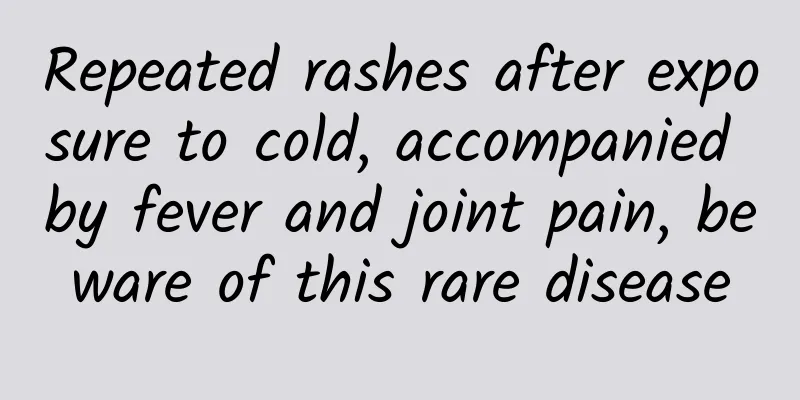Repeated rashes after exposure to cold, accompanied by fever and joint pain, beware of this rare disease

|
Author: Gao Fengqiao, MD, Beijing Children's Hospital, Capital Medical University Reviewer: Li Caifeng, Chief Physician, Beijing Children's Hospital, Capital Medical University What should have been a happy childhood was instead plagued by illness! Xiaole (pseudonym) is an 8-year-old girl. She should have had a happy childhood in school, but she had to go to the hospital for repeated medical treatment. It was all because she began to have systemic urticaria 2 days after she was born, accompanied by low fever, with a body temperature of about 37.5℃, and repeated attacks once a week. The doctor considered it "dermatitis" and used a lot of topical ointments, but it didn't work. After the age of 2, Xiaole had intermittent bilateral knee pain in addition to rash and fever, and her walking was affected during the attack. Finally, Xiaole's family came to the Rheumatology Department of Beijing Children's Hospital. After examination, Xiaole's blood routine showed a significant increase in white blood cells, mainly neutrophils; inflammatory indicators C-reactive protein (CRP) and erythrocyte sedimentation rate (ESR) increased; pure tone audiometry indicated a decrease in left ear hearing; magnetic resonance imaging (MRI) showed enlarged liver and spleen, and effusion in both hip and knee joints. Genetic testing showed NLRP3 gene mutation. Combined with Xiaole's clinical manifestations, physical examination and auxiliary examinations, NLRP3-related autoinflammatory diseases were diagnosed. Figure 1 Copyright image, no permission to reprint After being treated with glucocorticoids, nonsteroidal anti-inflammatory drugs and biologics, Xiaole's rash and fever never recurred, his joint pain disappeared, his hearing loss recovered, and he returned to a happy school life. NLRP3-related autoinflammatory diseases have been included in the list of rare diseases NLRP3-associated systemic autoinflammatory disease (NLRP3-AID), also known as cryopyrin associated periodic syndrome (CAPS), is a group of autoinflammatory diseases caused by gain-of-function mutations in the NLRP3 gene encoding cryopyrin, which causes inflammasome activation. It can cause recurrent multi-system inflammation throughout the body, mainly manifested as fever, joint pain and urticaria. Foreign data show that the incidence of the disease is 1 case per 1 million people, and the prevalence is 0.34 to 5.5 cases per 1 million people. There is currently no research on the incidence of the disease in my country. The "Second Batch of Rare Diseases Catalog" issued by the National Health Commission in September 2023 has included this disease. The clinical manifestations vary in severity and complexity, and must be identified with caution! As a group of diseases, NLRP3-related autoinflammatory diseases can be divided into the following three types according to the severity of clinical manifestations. 1. Mild: Familial cold autoinflammatory syndrome (FCAS), which usually starts within 6 months after birth. Clinical symptoms include fever, rash (red macules, urticaria-like skin lesions), and joint pain within a few hours after exposure to a cold environment. It usually resolves on its own within 12 to 24 hours, recurs repeatedly, and lasts for life. Fever may be accompanied by chills, headaches, muscle aches, and conjunctivitis. It is generally not life-threatening and rarely leaves behind renal amyloidosis. 2. Medium: Muckle-Wells syndrome (MWS), which begins in infancy and may occur without cold environmental triggers, and also presents with fever, rash, joint pain, and conjunctivitis. Each attack lasts 24 to 72 hours. In adolescence, progressive sensorineural hearing loss occurs. In adulthood, systemic amyloidosis may occur, causing kidney damage, proteinuria, renal dysfunction, etc., with a poor prognosis. Figure 2 Copyright image, no permission to reprint 3. Severe: chronic infantile neurological cutaneous articular syndrome (CINCA) syndrome/neonatal-onset-multisystem inflammatory disease (NOMID), which can occur after birth. The disease is characterized by remittent fever lasting at least 2 weeks. Rash, arthritis and neurological symptoms are the typical triad. In severe cases, joint and bone deformities, epilepsy, transient hemiplegia, chronic meningitis, hydrocephalus, etc. may occur. As the course of the disease prolongs, there may be intellectual decline, progressive visual decline and progressive sensorineural deafness, resulting in serious sequelae. Typical symptoms may also manifest as delayed closure of the anterior fontanelle, macrocephaly, bulging forehead, and a special facial appearance with a collapsed nose, accompanied by short stature and hoarseness. If NLRP3-AID is considered, what auxiliary examinations should be done? 1. Routine blood test: increased white blood cell, neutrophil and platelet counts. 2. Inflammatory indicators: Increased levels of acute phase reactants such as CRP and ESR. Figure 3 Copyright image, no permission to reprint 3. Autoantibodies are negative. 4. Cerebrospinal fluid examination of chronic meningitis: increased intracranial pressure, increased polymorphonuclear leukocyte count, and increased protein quantification. 5. Pathology of urticaria rash: There is obvious neutrophil infiltration around the blood vessels. 6. X-ray of long bones in patients with skeletal involvement: shows epiphyseal lesions. 7. Brain imaging examination in patients with neurological involvement: shows ventricular dilatation, subdural effusion and brain atrophy. Early identification, early diagnosis, early treatment and long-term follow-up are the keys to improving prognosis! The diagnosis of NLRP3-AID should be suspected in children with recurrent unexplained fever and/or urticaria, especially those with a positive family history. Genetic testing is a valuable auxiliary examination method, but 50% of children lack evidence of NLRP3 gene mutations, so the diagnosis of NLRP3-AID is mainly based on clinical manifestations. Prognosis depends on early diagnosis and treatment. If treated early, most NLRP3-AID-specific symptoms are reversible. Therefore, it is crucial to treat NLRP3-AID patients early and actively to suppress the persistent autoinflammatory state by controlling inflammation, improve function, and avoid end-organ damage. Currently available therapeutic drugs include traditional drugs (nonsteroidal anti-inflammatory drugs, glucocorticoids, etc.) and targeted drugs [targeted interleukin-1 (IL-1) inhibitors]. How to quickly control inflammation early and reduce disability and mortality rates depends on the rational and standardized combination of different drugs. Individualized treatment is adopted. Please refer to the 2021 European League Against Rheumatism (EULAR) and American College of Rheumatology (ACR) "Guidelines for the Diagnosis and Treatment of IL-1-Mediated Autoinflammatory Diseases" and the 2022 China "Expert Consensus on the Diagnosis and Treatment of Children's Autoinflammatory Diseases". NLRP3-AID patients require long-term monitoring and follow-up in rheumatology specialist clinics. At the same time, collaboration with multidisciplinary teams such as ophthalmology, otolaryngology, neurology, and orthopedics is required to conduct regular monitoring based on disease activity and severity so that treatment plans can be adjusted in a timely manner to prevent the occurrence of complications. Through early identification, early diagnosis, early treatment and long-term follow-up, we can improve the prognosis of NLRP3-AID patients and enable children with rare diseases to thrive and live happily! References [1] Rheumatology Group of the Pediatric Branch of the Chinese Medical Association, Pediatric Group of the Rheumatology and Immunology Branch of the Chinese Medical Doctor Association, Pediatric Group of the Rheumatology and Immunology Professional Committee of the Cross-Strait Medical and Health Exchange Association, etc. Expert consensus on the diagnosis and treatment of pediatric autoinflammatory diseases [J]. Chinese Journal of Practical Pediatrics, 2022, 37(3):161-172. [2] Shen Min, Qing Yufeng, Shi Xiaofei, et al. Chinese Society of Rheumatology. Diagnostic criteria for autoinflammatory diseases[J]. Chinese Journal of Internal Medicine, 2021, 60(12):10 [3] KUEMMERLE-DESCHNER J B. CAPS--pathogenesis, presentation and treatment of an autoinflammatory disease[J]. Semin Immunopathol, 2015, 37(4):377-385. [4] ROMANO M, ARICI ZS, PISKIN D, et al. The 2021 EULAR/American College of Rheumatology points to consider for diagnosis, management and monitoring of the interleukin-1 mediated autoinflammatory diseases: cryopyrin-associated periodic syndromes, tumor necrosis factor receptor-associated periodic syndrome, mevalonate kinase deficiency, and deficiency of the interleukin-1 receptor antagonist[J]. Ann Rheum Dis, 2022, 81: 907-921. |
<<: Children's bronchoscope - the wonderful journey of "Mirror"
>>: Have you learned the trick of tapping your baby’s back to help him/her expel phlegm?
Recommend
Benefits of taking a ginger bath after childbirth
After giving birth, the mother must strengthen go...
What to do and what to eat when you have internal heat during pregnancy
If pregnant women are prone to getting angry, it ...
Leucorrhea has a sour smell
For women, the normality of many gynecological di...
Female right armpit pain
Pain in a woman's right armpit may be caused ...
Research finds | Nearly 26% of thin people also have fatty liver and need to lose weight to improve metabolic disorders!
Metabolic-associated fatty liver disease (MAFLD),...
1. How long does abdominal pain usually last after IUD insertion?
After a woman gives birth to a child, both partie...
Women should avoid using their hands to satisfy such physiological needs
The most annoying skin problem for young women is...
Will washing away blood lipids make your body healthy?
When the machine starts, the garbage in the blood...
What is the normal age for girls to have menstruation
As we all know, women have their first menstruati...
Leukocytic leukocyte esterase 20
Routine examination of leucorrhea can timely deal...
What is the treatment for breast duct discharge?
For breastfeeding women, nipples often secrete mi...
Treatment of turbid leucorrhea during ovulation
Many of us may not know much about the disease of...
The second line of the pregnancy test stick seems to be there
Many friends, when using pregnancy test sticks, t...
What is the meaning of cervical ca
Cervical CA is cervical cancer, which is a malign...
What is the yellow stuff coming out from below?
The yellow substance that flows out from below is...









